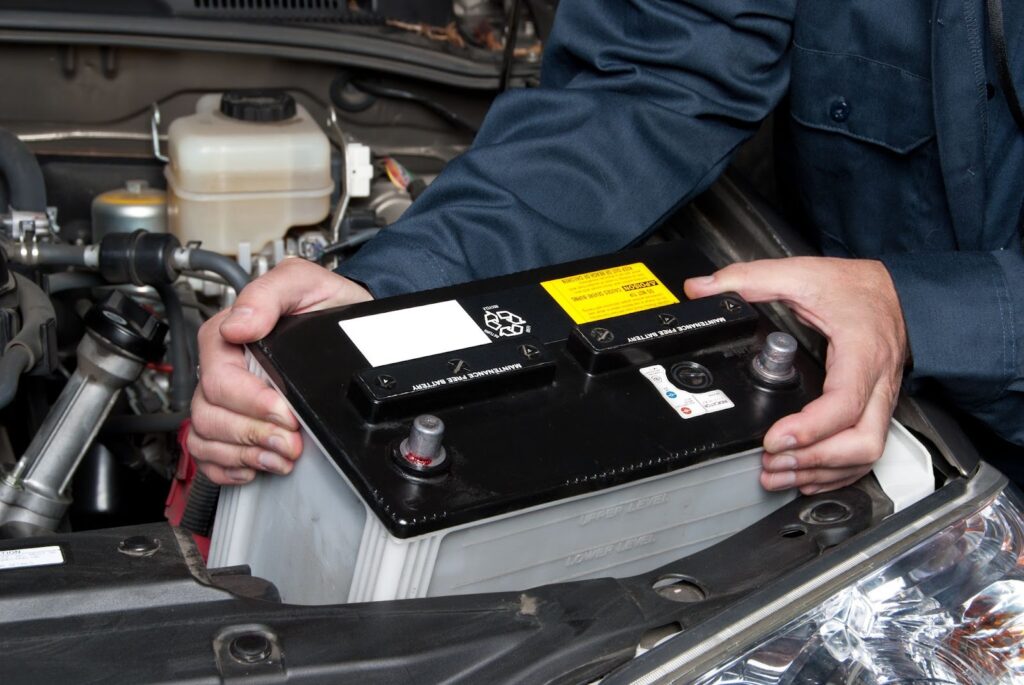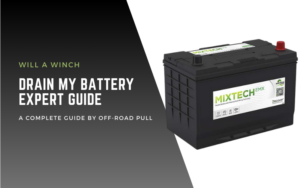Have you ever wondered what effect using a winch has on your vehicle’s battery?
Using a winch can drain your vehicle’s battery, especially with continuous use, but proper sizing, maintenance, and upgrading your electrical system can help prevent significant battery drain.
How Winches Affect Your Vehicle’s Battery

Power Requirements of Typical Winches
Winches are powerful tools, and like any powerful tool, they need a lot of energy to operate. Most winches are electric and draw power directly from your vehicle’s battery.
The power requirements of a winch depend on its size and capacity. For example, a small winch might need around 100 amps, while a larger one could draw 400 amps or more.
This high power draw can put a significant load on your vehicle’s electrical system.
Also check: Best winch battery in 2024
Factors Influencing Winch Power Consumption
Several factors influence how much power your winch consumes:
- Winch Size and Capacity: Larger winches with higher pulling capacities require more power. It’s essential to match your winch to your vehicle’s capabilities to avoid overloading the battery.
- Load Being Pulled: The heavier the load, the more power your winch will need. Pulling a fully-loaded trailer will use more power than dragging a small log.
- Duration of Use: Continuous use of a winch consumes more power than intermittent use. The longer you use your winch, the more strain you put on your battery.
Can a Winch Drain Your Battery?
Short Answer: Yes, using a winch can drain your battery. However, the extent of this drain depends on several factors.
These include how much power the winch consumes, how long you use it, and the condition of your vehicle’s electrical system.
Scenarios Where Battery Drain Is More Likely to Occur
Certain situations increase the likelihood of your winch draining the battery:
- Extended Use Without Recovery Time: If you use your winch for long periods without giving the battery a chance to recharge, the battery will drain faster. For example, if you’re trying to pull a heavy load for several minutes without stopping, the continuous power draw will quickly deplete the battery.
- Old or Not Fully Charged Battery: An older battery or one that is not fully charged is more susceptible to draining. Older batteries have reduced capacity and can’t hold a charge as well as newer ones. Similarly, a battery that isn’t fully charged from the start will run out of power faster.
- Continuous Use Without Breaks: Using the winch continuously without allowing any breaks puts a constant load on the battery. This prevents the alternator from recharging the battery, leading to quicker depletion.
Impact of Continuous vs. Intermittent Winch Use
- Continuous Use: When you use a winch continuously, it draws power from the battery non-stop. This sustained power draw doesn’t give the alternator enough time to recharge the battery. As a result, the battery’s charge depletes rapidly. This is especially problematic if you’re in a situation where you need to use the winch for several minutes at a time without stopping.
- Intermittent Use: Intermittent use of a winch involves pulling in short bursts with pauses in between. These breaks give the alternator time to recharge the battery, helping to maintain its charge level. This method is less taxing on the battery and can significantly reduce the risk of draining it completely. By allowing the alternator to do its job, you can extend the overall runtime of the winch and prevent battery drain.
Understanding Your Vehicle’s Electrical System
Battery Capacity and Voltage
Your vehicle’s battery is rated by its capacity, typically measured in amp-hours (Ah), and its voltage, usually 12 volts for most vehicles.
A high-capacity battery can store more energy, which is crucial for running high-power devices like a winch.
Alternator Output and Its Role in Recharging
The alternator plays a vital role in keeping your battery charged. It converts mechanical energy from the engine into electrical energy, which is then used to recharge the battery.
A higher output alternator can provide more power to recharge the battery faster.
Importance of a Healthy Battery for Winch Operation
A healthy battery is crucial for winch operation. If your battery is weak or old, it won’t hold a charge well and may not be able to provide the necessary power for your winch. Regular battery maintenance and timely replacement are essential.
Preventing Battery Drain When Using a Winch
Proper Winch Sizing for Your Vehicle
To prevent your winch from overloading your vehicle’s electrical system, it’s crucial to use a winch that is appropriately sized for your vehicle. This means selecting a winch with a power requirement that your battery and alternator can handle.
Check your vehicle’s specifications and choose a winch that aligns with those specs. Using a winch that is too powerful for your vehicle can strain the battery, leading to faster drain and potential damage to the electrical system.
Using Synthetic Rope to Reduce Power Consumption
Switching from a traditional steel cable to a synthetic rope can help reduce power consumption. Synthetic rope is significantly lighter and more flexible than steel cable, which means it requires less power to pull a load.
This reduction in power requirement can ease the strain on your battery, making your winch more efficient and less likely to drain the battery quickly.
Maintaining Engine RPM During Winching
While using the winch, it’s important to keep your engine RPM up. Doing so helps the alternator generate more power, which can recharge the battery faster and reduce the load on it. This practice is particularly useful during heavy winching operations.
By maintaining a higher RPM, you ensure that the alternator provides a steady flow of power, preventing the battery from draining too quickly.
Installing a Deep Cycle or Auxiliary Battery
Installing a deep cycle battery or an auxiliary battery can be a game-changer for those who frequently use their winch.
A deep cycle battery is designed to provide a steady amount of power over a longer period, making it ideal for winching tasks that require prolonged use.
Alternatively, an auxiliary battery can share the load with the main battery, ensuring that the main battery does not drain too quickly.
This setup allows for extended winch use without compromising the starting power of your vehicle’s primary battery.
Signs of Battery Drain During Winch Use
Dimming Headlights or Dashboard Lights
If you notice your headlights or dashboard lights dimming while using the winch, it’s a sign that your battery is being heavily taxed. This is an early warning that your battery may be getting drained.
Slow Winch Operation
A winch that operates more slowly than usual indicates that it’s not getting enough power, often due to a drained battery.
Difficulty Starting the Engine After Winching
If your engine struggles to start after using the winch, it means your battery is low on charge. This can be a serious issue if you’re in a remote location.
Best Practices for Winch Operation
Limiting Continuous Winch Use
Using a winch continuously for long periods can quickly drain your vehicle’s battery. To prevent this, avoid prolonged, uninterrupted winching.
Instead, use the winch in shorter bursts, giving your battery and electrical system a chance to rest and recover between uses. This practice helps prevent overheating and reduces the overall strain on your battery.
Allowing Recovery Time Between Winch Pulls
Between winch pulls, allow time for your battery and alternator to recover. During these breaks, the alternator can recharge the battery, helping to maintain its charge level and prolonging its life.
By pacing your winch use, you ensure that your battery doesn’t become depleted too quickly, which is crucial in maintaining a reliable power source for your vehicle.
Regular Battery and Alternator Maintenance
Regular maintenance of your vehicle’s battery and alternator is key to ensuring they remain in good working condition.
Clean the battery terminals to prevent corrosion, check the connections to ensure they are tight and secure, and periodically test the alternator output to confirm it’s charging the battery effectively.
Keeping your battery and alternator in top shape reduces the risk of unexpected failures and ensures your winch performs reliably when you need it.
Upgrading Your Electrical System for Heavy Winch Use
High-Output Alternators
Upgrading to a high-output alternator can be a smart move if you frequently use your winch for heavy-duty tasks.
A high-output alternator generates more electricity than a standard one, allowing it to recharge your battery faster. This means that even during prolonged winching, your battery will have a better chance of staying charged.
With a high-output alternator, you can use your winch more confidently, knowing that your electrical system can handle the increased demand.
Dual Battery Setups
A dual battery setup is another effective solution for heavy winch use. This involves installing a second battery in your vehicle. The main advantage of having two batteries is that it provides extra power, reducing the strain on your primary battery.
The secondary battery can take on the additional load from the winch, ensuring that the main battery remains charged enough to start the vehicle and run other essential systems.
This setup is particularly useful for off-road enthusiasts and those who use their winch regularly.
Battery Isolators and Management Systems
Battery isolators and management systems are essential components when using a dual battery setup.
A battery isolator separates the two batteries, ensuring that power is drawn from the secondary battery for the winch while keeping the main battery charged.
Management systems can automatically control the charging and discharging of both batteries, optimizing their performance and lifespan.
These systems help manage power distribution effectively, so you don’t have to worry about one battery draining too quickly or the other not being charged properly.
Conclusion
Using a winch can put a significant load on your vehicle’s battery, but with proper understanding and precautions, you can prevent battery drain and ensure reliable winch operation.
By maintaining your electrical system, using the right equipment, and practicing smart winch use, you can keep your adventures on track without worrying about battery issues.


